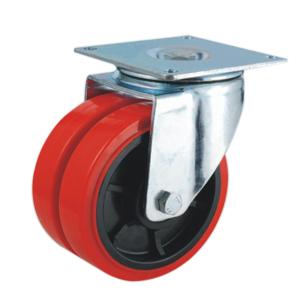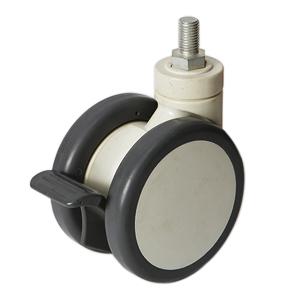Comparison of single and double casters
Comparison of single and double caster wheels
The most common form of casters is single-wheel. In some cases, double-wheel structure is also used. What is the difference between single-wheel structure and double-wheel structure?
1. Compared with the caster with the same single wheel, the caster with the double-wheel structure has a higher load capacity;
On the premise that the support bracket is strong enough, the load capacity of the double caster is significantly higher than the load of the single caster, and theoretically can reach twice the load of the single caster.
2. Compared with single-wheel casters, the rotation resistance of double-wheel casters is smaller. For the same load weight, the rotation resistance of double-wheel casters is more than 40% lower than that of single-wheel casters.
When rotating in place, the single-wheel caster rotates, and there is sliding friction between the wheel and the ground; while when the two-wheel caster turns, the two wheels move in opposite directions, and there is rolling friction between the two wheels and the ground.
3. Compared with single-wheel casters, double-wheel casters have a larger contact area with the ground, and the stability of the car body is better.
4. For the same caster with single wheel, the price of double-wheel caster is higher than that of single-wheel caster. Not only is there one more wheel, the bracket of the double-wheel is also stronger, the load capacity is stronger, and the cost is higher.
Under what circumstances are single-wheel casters used? Under what circumstances do you use double casters?
If the single-wheel casters can meet the requirements of use, then there is no need for double-wheel casters!
Under what circumstances need double caster wheels meet the requirements?
(1) There are load requirements on the wheels, and the installation space is limited
(2) The center of gravity of the vehicle with casters should not be too high;
(3) Where rotation resistance is an important factor in evaluating the performance of casters;
(4) The occasions that require high body stability.



 English
English Spanish
Spanish German
German Russian
Russian Arabic
Arabic Portuguese
Portuguese Italian
Italian French
French Hebrew
Hebrew Turkish
Turkish